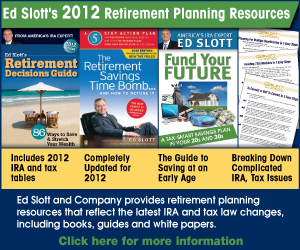IRAs are different, complicated, but in the end, a great avenue for retirement planning. In this week's Slott Report Mailbag, we answer questions on required minimum distribution rules (RMDs), IRA contribution limits and how to take withdrawals if you are a non-designated beneficiary. As
always, we stress the importance of working with a competent, educated
financial advisor to keep your retirement nest egg safe and secure. Find
one in your area at this link.
1.
Hey Ed,
 |
| Send your questions to [email protected] |
My sister-in-law claims that by taking less than $10,000 a year from her IRAs she doesn't have to pay tax on the money. I am 74 years old and have paid tax on my IRAs the last couple of years. Her other income is social security. Is that possible?
Thank you,
Jerry Gerber
Answer:
At age 70 ½ there are required distributions from an IRA. Your sister-in-law should be sure that she is taking at least that minimum amount from her IRA each year. There is a 50% penalty on any shortfall of the required amount. Distributions from IRAs are generally subject to income tax, other than after-tax money and qualified distributions from Roth IRAs. Distributions from an IRA are added to all of your other income to determine the applicable tax rate that will apply. It is possible that an individual’s total income could be low enough, after deductions, to avoid income taxes.
2.
If an employer caps the employee 401(k) contribution at 20% (or any other cap) and it is less than the $17,000 (or over age 50, $22,500) IRS allowed amount, may the employee put the difference, if no more than the IRA limit, into either a traditional IRA or Roth IRA?
Answer:
If you have earned income, regardless if you contribute to a 401(k) plan or any other employer plan, you can always, as long as you are under age 70 1/2 for a traditional IRA and no age limit on Roth IRAs, contribute to an IRA. For traditional IRA contributions to be income tax deductible, you must meet certain income limits. In 2012 if you are married filing jointly, your contribution deductibility will begin to phase out at $92,000 and completely phase out at $112,000. There are also phase-outs for contributions to Roth IRA,s which begin at $173,000 - $183,000. If income is over $183,000 you cannot contribute to a Roth IRA.
The IRA contribution limit is $5,000 plus an additional $1,000 if age 50 or older.
3.
Dear Ed:
My sister and I are the non-designated beneficiaries of our sister who died in 2011. We are finally able to take withdrawals, but the advice on how much and when has been complicated. Withdrawals have to go into the estate and then on to us. Our accountant says we can withdraw over 10 years. My financial planner isn't sure. Again, we are not designated beneficiaries so the usual timelines apparently don't apply. The custodian has told us different things on different occasions. And what about the tax implications? How can we reduce those?
Thanks for any help,
Pat R
Answer:
The distribution rules are in fact very confusing. For non-designated beneficiaries, the distributions depend on whether the IRA owner died before or after their required beginning date (RBD). For example, there is a 5-year payout if the IRA owner died before their RBD and if they died after their RBD the estate can use the continuing life expectancy of the decedent. There is not much you can do to avoid income on the distributions. You should consult your tax advisor for tax planning strategies that will fit your needs.
-By Marvin Rotenberg and Jared Trexler




 Articles That Move
Articles That Move







0 comments:
Post a Comment